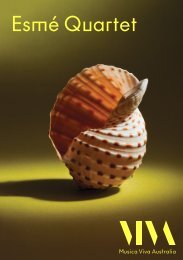You also want an ePaper? Increase the reach of your titles
YUMPU automatically turns print PDFs into web optimized ePapers that Google loves.
<strong>Program</strong> 1<br />
The death of Beethoven in early 1827 deeply<br />
affected the 30-year-old Franz Schubert,<br />
who himself only had 18 months to live, and<br />
perhaps spurred him to even greater creative<br />
heights. That same year Schubert wrote the<br />
monumental song cycle Winterreise, the<br />
magnificent last three piano sonatas, the two<br />
piano trios and other extraordinary works<br />
including the Impromptus for piano. The<br />
C minor Impromptu is a work of haunting<br />
beauty. The melancholy opening theme is<br />
immediately captivating, its brooding minor<br />
restlessness giving way to a lyrical, more<br />
soothing version of the theme but now in A-flat<br />
major. The transition from minor to major keys<br />
is an important feature of Schubert’s music,<br />
both for harmonic colour and also for the<br />
implied change in emotional inflection. After<br />
a series of variations alternating between<br />
major and minor versions of the themes and<br />
culminating in a powerful climax, the<br />
opening melody returns, but now finally in<br />
C major, signalling a sense of acceptance<br />
and resolution.<br />
Franz Liszt and Franz Schubert could not<br />
have been more different in personality and<br />
in their engagement with society. Schubert<br />
was shy and introverted, kept a small circle<br />
of close friends and rarely ventured out in<br />
public. Liszt, on the other hand, was a highly<br />
charismatic extrovert, a flamboyant showman<br />
who travelled extensively. Nonetheless, Liszt<br />
was strongly influenced by Schubert’s music.<br />
He transcribed dozens of Schubert’s songs for<br />
solo piano and arranged Schubert’s extended<br />
piano work Wanderer Fantasy as a concerto<br />
for piano and orchestra.<br />
Liszt’s Sonata in B minor has some striking<br />
similarities with the Wanderer Fantasy. Both<br />
works are played straight through without a<br />
break yet are internally subdivided into four<br />
movements. Furthermore, in both works, the<br />
musical material is based on themes heard at<br />
the beginning which are transformed or varied<br />
as the piece unfolds, creating a sense of unity<br />
within the larger structure. In the Liszt sonata<br />
four musical ideas form the basis for the whole<br />
work. We hear the first three immediately – a<br />
descending scale, a leaping octave passage<br />
and a low-register gruff theme based on<br />
repeated notes. The fourth, a chorale-like<br />
theme, appears around three minutes in.<br />
Liszt’s transformations and variations of<br />
these ideas is masterly. One of the most<br />
striking occurs in the sonata’s slow movement<br />
where the opening low gruff theme becomes<br />
an elegant and dreamy melody, singing<br />
beautifully in the treble register. Immediately<br />
after this section, the leaping octave theme<br />
serves as the basis for a powerful and<br />
extended fugal passage.<br />
The sonata was not universally well received<br />
at first. Its uncompromising sound world,<br />
musical and technical complexity, and<br />
06


















